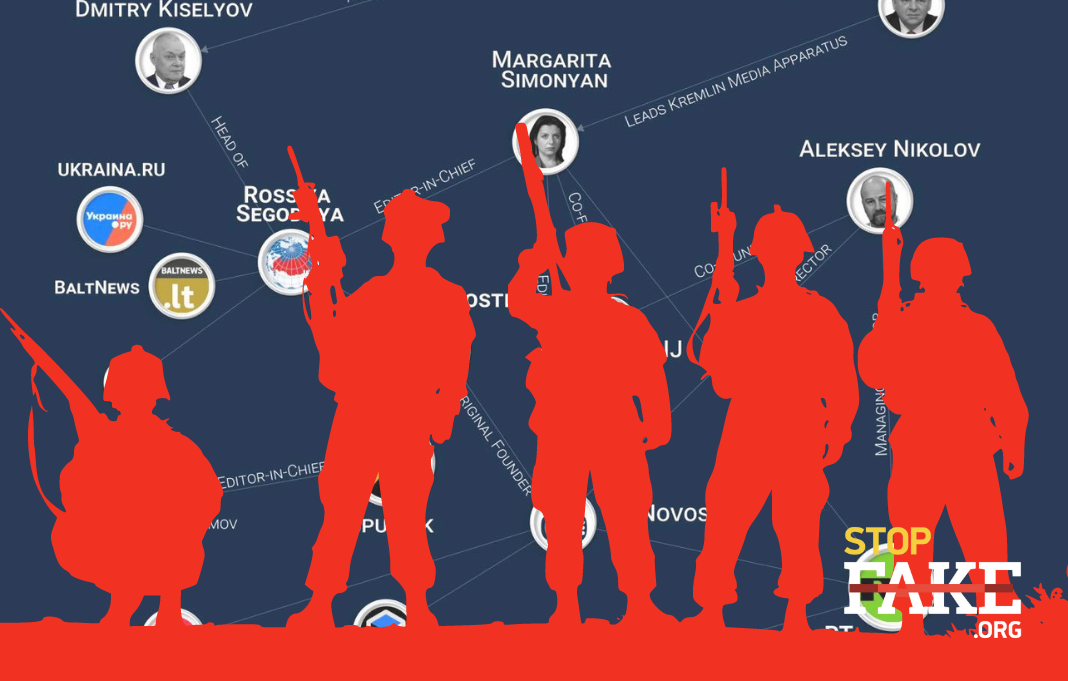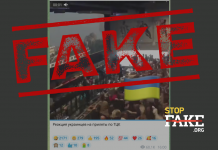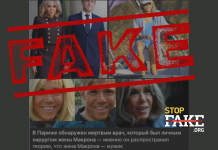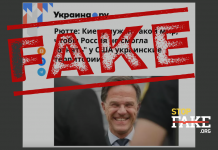By Yevhen Fedchenko, StopFake chief editor, Kyiv Mohyla School of Journalism Director
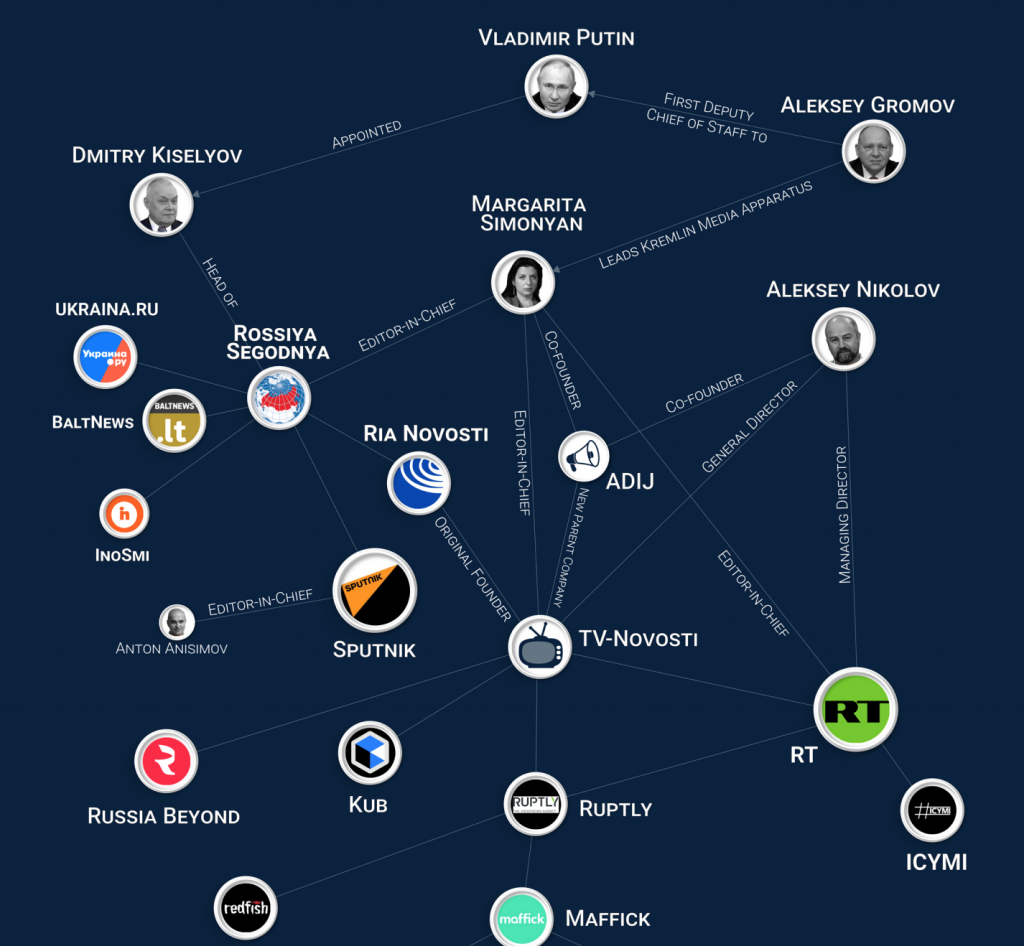
As Russian forces amass around Ukraine’s borders and Moscow prepares to expand its aggression, the volume of disinformation is going up significantly, it is full of warmongering, hate speech and promises to annihilate Ukraine.
Under these circumstances disinformation is more dangerous than ever.
It is a paramilitary instrument of war against Ukraine, intended to delegitimize Ukraine’s sovereignty and completely dehumanize Ukrainians. Furthermore, disinformation creates a parallel reality for millions of Russians, militarizing their mindset and preparing for future war – with Ukraine, NATO, the West.
Russian decision-makers already live in this parallel reality they themselves created. Their manufactured fakes have become a part of their own modus operandi and decision-making process. President Putin is a disinformation master in his own right, he constantly pushes fake narratives – about Ukraine, history, Donbas, NATO etc.
Disinformation and propaganda are used to promote and normalize war, they create enormous psychological pressure on Ukrainians, create provocations and justify future atrocities.
Russian media has reached a level of hate speech and warmongering that can be compared with the genocidal rhetoric of Rwandan media on the eve of the 1994 genocide, when Radio Télévision Libre des Mille Collines called Tutsis ‘cockroaches’ and called for their killing simply because they belonged to the antagonized ethnic group.
Similarly, Anton Krasovsky, director of the Russian state-funded RT channel, in his broadcast called Ukrainians ‘animals’ and said he will burn the Ukrainian constitution on Kyiv’s main street.
Talks about killing Ukrainians became the new benchmark on all Russian talk shows where plans to destroy Ukraine are discussed daily. It became a new norm when Russia’s chief female propagandist Olga Skabeyeva called Ukraine a ‘terrorist state’ and her talk show guest Vladimir Zhirinovsky suggested that Moscow nuke Kyiv.
Let us be perfectly clear and let this fact sink in: Russian TV show hosts and invited ‘experts’ are openly discussing killing Ukrainians as an ethnic group, dehumanizing, and degrading an entire people.
Recently they upgraded and broadened this narrative: now not only Ukraine but the West too should be destroyed, to support this narrative they show maps with projectiles of Russian nuclear missiles hitting targets throughout the world.
Main Disinformation Themes
StopFake mapped the main narratives used by the Russian disinformation ecosystem since 2014, narratives that have remained relevant ever since. With the recent Russian military escalation there are visible spikes within some of the existing narratives and there is a growing possibility they can be used for potential provocations or even for the creation of a casus belli against Ukraine.
- Deligitimization of Ukraine. Disinformation continues to build a case that Ukraine is not a real country, is not a country at all, it is an artificial creation and there is no such thing as Ukrainians. Putin personally takes a leading voice in this falsification of history.
- Ukraine is ‘externally administered’ by the United States. The recent escalation is also allegedly a result of US and British ‘aggressive politics’ and the aftermath of arming of Ukraine. The recent cyber-attack on Ukraine is also attributed to the US and Britain – the ukraina.ru propagandist site calls the hacking “the fruit of Ukraine’s Washington curators, who desperately need to increase the level of accusations against Russia.
- Foreign military training personnel are actively used in the Donbas conflict, arms supplied to Ukraine will be to be used for offensive operations in Donbas or Crimea. NATO bases are already de facto in Ukraine. Arms supplied to Ukraine will end up on African, Middle East or European weapons black markets.
- Ukraine is going to take Donbas by force. Ukrainian government and armed forces are allegedly conducting or preparing to conduct genocide in Donbas. This ‘genocide’ is carried out through indiscriminate shelling, use of prohibited weapons, causing water and gas supply problems and other humanitarian issues. Propagandists claim that people living in annexed Crimea and captured regions of Ukraine’s Donetsk and Luhansk provinces were “deprived of Ukrainian citizenship” and if they chose to take Russian passports they will be prosecuted and imprisoned. Newly created Territorial Defense units are also immediately labeled as a ‘punitive force’ intended to bring ‘carnage in Donbas’ – “A massacre is coming”, they warn. Putin also has personally mentioned ‘genocide’ many times. The concept of ethnic cleansing is often used within this context.
- Ukrainians are Nazis, who live in a Nazi state, the Ukrainian army is a hotbed for far-right radicals. That’s why Ukraine should not be provided with weapon as they immediately fall into the hands of radicals. Ukrainian Nazis are freely operating not only in Ukraine but also in Russia. StopFake debunked a story about an alleged Ukrainian Nazi in Voronezh. This fake was reported by numerous Russian media, including Kommersant, TASS, Rossiyskaya gazeta, RIA Novosti, and many others. They reported that followers of a Ukrainian neo-Nazi organization MKU (“Manyaky. Kult ubiyts” – “Maniacs. Cult of Murderers”) were detained. Later Russia’s security service, the FSB ‘uncovered’ MKU cells in dozens of Russian cities, 106 people were detained and weapons caches ‘discovered’. This ‘Ukraine-related’ network allegedly was preparing an assault against journalists in the Rostov region and recently it was “discovered” that Ukrainians were also responsible for a bus explosion in Voronezh in August 2021. Back in August all Russian media reported that the reason for the blast was poor technical maintenance of the bus.
- Ukrainian armed forces, with support from the US, will use weapons of mass destruction (most likely biological or chemical) in Donbas and blame Russia. The source of this weapon will be one of the ‘secret’ US laboratories scattered around Ukraine and controlled by… the Pentagon.
- Ukraine is an unreliable gas supplier to Europe. It’s not the Nord Stream 2 project but Ukraine that is a threat to Europe’s energy security.
All these narratives set a stage for further Russian aggression against Ukraine and any piece of fake news can be used as a pretext for another incursion.
What Can be Done?
In order to disarm the information war ecosystem, measures should be taken to neutralize the main institutions and personalities involved in the production and distribution of disinformation.
For this battle plan we can borrow the military concept of the Kill Chain that identifies the sequence of attack: identifying the target, identifying the target’s location, monitoring the target’s movements and finally destruction of the target. We have already passed through the first three stages with disinformation: we know who is involved in its manufacturing, we have mapped their ecosystem, we have monitored their narratives. Finally, we need to engage and eliminate this system.
First of all, we all need to agree – they are not media andthey should not be treated as media. They should be treated exactly as what they really are: information combatants who must share responsibility with the Russian political and military leadership for their crimes against Ukraine.
As soon as we recognize these organizations are not media, they should be deplatformed in order to limit their audience reach. We can use the same approach as Germany used against RT Deutsch – it was taken off the air days after launch. Because it’s not about freedom of speech but about freedom of reach, this right is not universal and should not be granted to malign influence organizations. Cooperation with social media platforms is essential for this.
Then we need to sanction all major figures involved in the manufacturing and distribution of disinformation. The Russian disinformation and propaganda ecosystem is already very well researched, mapped and defined in the Global Engagement Centre Special Report as “the collection of official, proxy, and unattributed communication channels and platforms that Russia uses to create and amplify false narratives.” So far, the only person sanctioned for this is Dmitry Kiselyov, the head of Russia’s government-owned news agency Rossiya Segodnya. On January 19, 2022, the “Putin Accountability Act” was introduced in the United States by Republican Jim Banks. This bill proposes to impose personal sanctions on Simonyan, Vladimir Solovyov and Konstantin Ernst.
We should expand this list to include other important stakeholders:
- RT: Alexey Nikolov, Managing Director, heads of RT language services and country offices (Anton Krasovsky)
- Rossiya Segodnya: Margarita Simonyan, chief editor, Kiril Vyshynsky, Executive Director
- Sputnik: Anton Anisimov, chief editor, heads of Sputnik language services and country offices (Andrey Blagodyrenko, curating ukraina.ru and Baltnews)
- Ruptly: CEO Dinara Toktosunova
- Heads of Russian TV channels Rossia, NTV, Pervy Kanal, Zvezda, Tsargrad
- Presenters of daily and weekly propagandist TV shows Vladimir Solovyov, Olga Skabeeva, Evgeny Popov, Andrey Norkin, Artyom Sheinin, Anatoliy Kuzichev, Olesya Loseva, Tigran Keosayan, Irada Zeynalova, Roman Babayan
- Disinformation operators masquerading as ‘journalists’ – Alexander Lots, Andrey Kondrashov, Kirill Kleymyonov, Arkady Mamontov, Dmitry Steshin
All of these people share personal responsibility for fueling the war in Ukraine since 2014. And even if Margarita Simonyan boasts of being included on the list, real sanctions might have very a different effect on those people and organizations.
And finally – companies should withdraw their advertising money from Russian media that is part of the disinformation ecosystem to make sure they do not co-finance malign operations alongside the Kremlin. If we examine the list of top advertisers on Russian TV and online, we see they are mostly western FMCG (fast-moving consumer goods) companies like PepsiCo, Procter and Gamble, MARS, McDonalds, Nestle, Reckitt Benckiser, L’Oreal, Danon, Ferrero, pharmaceutical companies GSK, Bayer AG, Berlin-Chemie Menarini, Sandoz, car manufacturer Volkswagen.
Withdrawal of advertising is not a new phenomenon – some companies already initiated this in Belarus in 2021. According to the Libereco Partnership for human rights report, there was ‘no more commercials from Carlsberg (Denmark) and L’Oreal (France), Nestlé significantly reduced its advertising from a 9 percent share in July to 0.4 percent in November. Similarly, the share of Coca Cola’s commercials dropped from 4 percent in July to 0.2 percent in November 2021’.
If these companies will follow suit in Russia and remove their advertising from the Russian disinformation ecosystem, this will be a real contribution to tackling fake news and hate speech.
StopFake continues to do monitoring, archiving and debunking of Russian disinformation on Ukraine to make sure that these crimes are well documented and those who perpetuate this information war and hijack journalism for this purpose will be identified and prosecuted through the international justice system.


